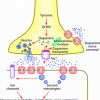But there is also another context that gets ignored. That is, the *mostly* good things about nuts. Such as the mineral profile and the fact that many nuts are higher in antioxidants than people think. Given this context it is suitable to question whether or not these components help to offset the effect of the PUFAs.
I am inclined to agree.
A ton of positive research has been done on nuts. Admittedly, a lot of it is financed by nut-producing interests, but still plenty of independent research backs up the consistent association of nut consumption with many measures of health, including improved mortality. I have ploughed through enough such research to set my mind at rest about the amount of polyunsaturates I absorb from my nut habit (one or two 25g snacks a day) or about any notional ideal ratio between Omega-6s and Omega-3s.
It seems to me that the case against polyunsaturates is never based on studies of nut consumption. Polyunsaturates have often been linked with oxidative damage in the body, and therefore nuts, which are rich in such oils, are associated by implication. When you read the anti-polyunsaturate theorising of people like Ray Peat and Danny Roddy, they tend to tar nuts with the same brush as cooking oils. But I do not think they can point to research in which nut consumption is directly linked to ill health caused by polyunsaturates.
We are often told how quickly polyunsaturates go off and how dangerous this is. But what strikes me when I look at my packs of nuts is how long they stay edible. They are among the slowest of all foods in my kitchen to perish. Even when they taste slightly stale, they are still far from rancid. I think this is because in nature nuts are designed to last a long time without rotting after they fall from the tree, since they need to survive through winter before the time comes to sprout. The matrix of nutrients in them keeps them intact, and so the various phytates, antinutrients, antioxidants, toxins, or whatever they contain prevent their polyunsaturated oils from oxidising. Therefore, even though rancid polyunsaturates are something to beware of in food, the virgin ones in whole nuts are likely nothing to be afraid of at all.
Edited by Gerrans, 02 December 2013 - 08:10 PM.






















































